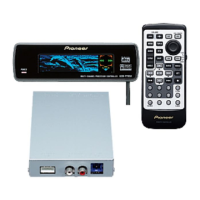
Do you have a question about the Pioneer AXM-P7650 and is the answer not in the manual?
| Detachable Face | Yes |
|---|---|
| Remote Control | Yes |
| CD Changer Controls | Yes |
| Total Harmonic Distortion | 0.008% |
| Digital Output | No |
| DIN Size | 1 DIN |
| Preamp Voltage | 4V |
| Channels | 4 |
| Output Voltage | 4V |
Provides guidance on using the operation manual, unit features, and compatibility.
Explains the unit's digital and analog source inputs and their assignments.
Lists important safety and operational precautions for using the unit and remote.
Instructions for installing the battery and proper use and care of the remote control.
Explains how to switch the remote control's operation mode (DVD, DEQ, AUDIO).
Details reverse mode behavior and compatibility with Dolby Digital/DTS formats.
Identifies and explains the unit's display indicators (Power, Information).
Details the functions of various buttons on the remote control for different modes.
Procedures for powering the unit on and off using the SOURCE button.
How to select audio sources and adjust their volume levels.
Switching between function names during DVD, Video CD, and CD playback.
Functions for CD playback including repeat, random, scan, and pause.
Allows resuming playback from a selected scene when the disc is reloaded.
Basic steps to select the TV source, adjust sound, and tune channels.
Procedures for storing, recalling, and automatically saving broadcast stations.
Basic steps to select and play a CD from the multi-CD player.
Details limitations and supported functions for 50-disc models.
Overview of advanced functions like Repeat, Random, and ITS Play.
Functions for scanning, pausing, creating, and managing ITS playlists.
How to play, delete tracks, or delete entire CDs from your ITS playlist.
Inputting, displaying, selecting discs by title, and using CD TEXT features.
Viewing and scrolling disc, artist, and track information on CD TEXT discs.
Adjusting sound quality using COMP (compression) and DBE (bass emphasis) functions.
Overview of DSP settings and how to navigate the DSP menu.
Accessing DSP functions and using the Sound Field Control (SFC) feature.
Adjusting sound field position and speaker balance for optimal listening.
Adjusts volume levels of each source to prevent drastic changes when switching.
Controlling dynamic range and overriding audio settings for testing.
Creates five-channel surround from two-channel sources for matrix surround.
Fine-tuning sound field using Music mode and playing multi-channel audio in 2 channels.
Configures speaker size (LARGE/SMALL/OFF) and non-installed speaker settings.
Adjusting subwoofer phase and setting crossover frequencies for optimal bass reproduction.
Readjusting speaker output levels using music or a test tone for balance.
Adjusting speaker distance and delay times for optimal sound image and balance.
Automatic adjustment of time alignment and equalization based on car acoustics.
Pre-operation checks and step-by-step instructions for performing auto TA and EQ.
Lists and explains how to recall and use various stored equalizer curves.
Detailed steps to adjust EQ bands (Low, Mid, High) for CUSTOM1/CUSTOM2 curves.
Overview of initial setup options for the unit.
Procedures for setting the clock and controlling display dimming.
Adjusts display brightness, corrects sound distortion, and manages phone call audio.
Activates the auxiliary input for using connected auxiliary equipment.
Enables and configures digital/analog sources and selects input connection methods.
Restores all audio functions, except volume, to their default settings.
Controls clock display visibility and switches between various entertainment display modes.
Allows changing displayed titles for digital and analog sources.
Connects and selects auxiliary equipment as an input source.
Changes AUX source title and selects remote control code type for DVD players.
Step-by-step guide for inputting custom titles for sources and discs.
Operates preprogrammed functions for each source using BOOK.M.
Provides solutions for common problems like power failure, remote control issues, and no sound.
Details error messages related to disc playback (e.g., ERROR-02, TEMP, ERROR-10, NON PLAY).
Explains error messages that may occur during auto TA and EQ measurements.
Lists technical specifications for the unit, display unit, and remote control.